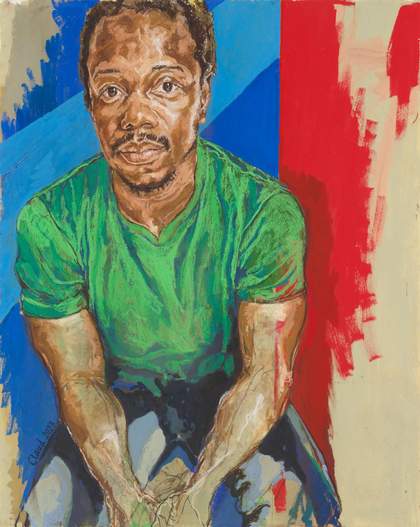
Claudette Johnson MBE
Young Man in Green (2023)
Tate
We know that not everyone has equal access to art and its benefits. We are committed to changing this through our work, and to challenging ourselves to dismantle the structures within our own organisation which perpetuate that inequality.
The founding of our gallery and the building of its collection are inextricably connected to Britain’s colonial past, and we know there are uncomfortable and inappropriate images, ideas and histories in the past 500 years of art which need to be acknowledged and explored. We also recognise the intersections of race, gender, sexuality and class in the experience of inequality.
These are not new aims for Tate. We have a stated objective to become a more inclusive institution that reflects the world we live in now. But progress has not been fast or significant enough.
This page details Tate’s ongoing commitment to race equality. It will be regularly updated with information about what we are doing to address structural racism, charting our progress towards becoming a more inclusive organisation as part of an open and transparent process. It uses ‘Black, Asian and/or minority ethnic (BAME)’ as a signifier, however we recognise the discomfort that this terminology produces in reducing individuals of diverse heritage to a single category, and we are working to address this.
September 2025
Developments since our last update include:
- Building on work completed last year, a programme supporting and accelerating Tate’s ongoing commitment to race equality is being rolled out to leadership teams at Tate. This sets out to establish a shared knowledge and understanding related to race equality and anti-racism across the organisation. This is the continuation of work to create long-term change, and to develop and adapt different approaches over time.
- Tate’s annual Workforce Diversity Profile for 2023-24 has been published online, tracking progress towards having a workforce that more closely reflects the communities we serve. The latest figures show that 20% of staff for Tate Gallery identify within Asian, Black, Mixed or Other ethnic groups. For Tate Commerce this figure is 32% and for Tate Eats it is 33%.
- Tate’s programme in 2025 features several exhibitions and collection displays with themes relating to race, representation, and cultural heritage. These include an exhibition of new work by artist duo Hylozoic/Desires (Himali Singh Soin & David Soin Tappeser) at Tate Britain. Entitled The Hedge of Halomancy, the installation includes a film and an embroidered tapestry which interweave real and imagined histories from the Indian subcontinent. Tate Modern presented Europe’s first major solo exhibition dedicated to one of the most extraordinary figures in international contemporary art, Emily Kam Kngwarray (c.1914-1996). A senior Anmatyerr woman from the Sandover region in the Northern Territory of Australia, Kngwarray translated her ceremonial and spiritual engagement with her ancestral Country, Alhalker, into vivid batik textiles and monumental acrylic paintings. At Tate Liverpool + RIBA North The Plant that Stowed Away traced the connections between the trading history of cities like Liverpool and the global movements of plants and people through art in the Tate Collection. Tate St Ives featured textile collages by Malgorzata Mirga-Tas whose visual storytelling comes from a feminist perspective and challenges stereotypical representations of Roma people. She was the first Romani artist to represent a country at the Venice Biennale, and the first to have works acquired for the Tate collection.
- The Hyundai Tate Research Centre: Transnational continues to transform how Tate develops and shares knowledge about multiple art histories with individuals and organisations around the world, and offers new perspectives on global art histories. Over the past year it supported key research focusing on transnational networks of artists working at the intersection of art and technology for Tate Modern’s Electric Dreams exhibition.
- Tate’s latest acquisitions strategy includes a section focused on race equality which is regularly reviewed and continuously supplemented as it changes. Recent acquisitions of British works include photography by Mitra Tabrizian and Vanley Burke, paintings by Lubaina Himid and Claudette Johnson, an installation by Keith Piper, sculpture by Alberta Whittle, and film and video works by Isaac Julien and Steve McQueen. International acquisitions include installation by Arahmaiani, works on paper by Shashi Bikram Shah, paintings by Dia Al-Azzawi and Martin Wong, sculpture by Seyni Awa Camara, and film and video by Samia Halaby and Samson Kambalu. Additionally, paintings by the Frieze Artist Award 2024 winner Mohammed Z Rahman, along with works by Bani Abidi and Naminapu Maymuru-White were acquired through the 2024 Frieze Tate Fund supported by Endeavor.
- Tate’s social media channels serve a global audience and reflect the communities our galleries are part of. To support Tate’s mission to promote a more diverse art history, the team create content that meaningfully engages with the cultural calendar as well as platforming stories from a diverse range of artists and advocates each week. A recent campaign for South Asian Heritage Month resonated with audiences and marked a successful cross-team project with works by South Asian artists highlighted across Tate's galleries, digital and social media platforms. Artist profile films platforming under-represented voices published to Tate’s digital channels featured Malgorzata Mirga-Tas, Maria Magdalena Campos-Pons, Emily Kam Kngwarray, Hylozoic/Desires (Himali Singh Soin & David Soin Tappeser), Samia Halaby and Arahmaiani.
- The diversity profile of visitors to Tate’s galleries in 2024-25 has continued to trend upwards, with 18% of UK visitors from Black British, Asian British, Mixed or Other ethnic groups, compared with 16% in 2023-24 and 14% in 2022-2023. Looking at London visitors, 23% of Londoners at Tate Britain or Modern were from Black British, Asian British, Mixed, or Other ethnic groups. As in previous years, Uniqlo Tate Play has continued to attract a high proportion of minoritised ethnicity visitors, as did recent exhibitions of works by Zanele Muholi and Anthony McCall.
Further actions and progress can be viewed in the dropdown sections below.
Updated 12 September 2024
